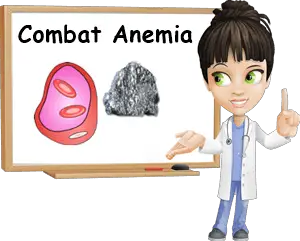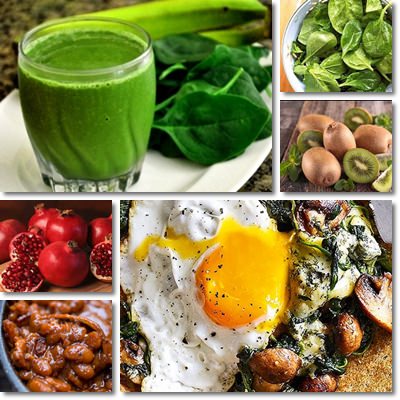Anemia is one the most common blood disorders. In order for a person to be diagnosed with anemia, he or she must have either a low red blood cell count or a low hemoglobin count, hemoglobin being a protein in red blood cells responsible for transporting oxygen to muscles. Generally, women are said to be more prone to developing anemia than men due to vitamin and mineral deficiencies and blood loss occurring as a result of pregnancy, nursing children and going through childbirth.
However, poor diet, genetic predispositions as well as several medical conditions creating a tendency for blood loss such as ulcers, Crohn’s disease, hypothyroidism, cancer and old age represent risk factors for anemia that affect both genders equally.
The question is: how can we combat anemia? The answer is through diet and good eating. Including both iron-rich foods into our diet, as well as vitamin C-rich foods to help increase iron absorption are crucial for managing anemia.

A main risk factor for anemia is, as mentioned above, blood loss. You don’t need to lose great amounts of blood at once to develop anemia. Brushing your teeth too hard, to the point your gums bleed can contribute to the condition if you accidentally hurt your gums every day.
Small cuts and scratches, bleeding hemorrhoids, canker sores, nosebleeds and other forms of imperceptible blood loss can slowly increase overall blood loss and make you susceptible to developing anemia. Other times, anemia is caused by a lack of iron in your diet or digestive problems that make iron absorption difficult.
What causes anemia?
This is a list of the are the most common causes for anemia:
- Iron deficiency. Iron is a crucial component of hemoglobin and supports normal hormonal processes responsible for red blood cell production.
- Vitamin B12 deficiency. Vitamin B12 is important for the formation of red blood cells.
- Folic acid (vitamin B9) deficiency. Folate plays a part in red blood cell formation.
- Nursing children and donating blood both affect iron reserves.
- Losing blood regularly as a result of bleeding gums, cuts, injuries, stomach ulcer, hemorrhoids, childbirth and so on.
- Smoking. Smoke constricts blood vessels.
- Old age which brings with it growing nutritional demands.
- Parasitic worm infestations.
- Hereditary diseases. Example: sickle cell anemia, a genetically predisposed blood disease in which red blood cells have a crescent form or a sickle shape. Not only are these cells more likely to get stuck in blood vessels, but they are also unable to properly oxygenate blood.
- Abusing ibuprofen, aspirin and other non-steroidal anti-inflammatory drugs.
- Undergoing gastrointestinal surgery.

Signs and symptoms of anemia
Lethargy
Anemic people lack energy altogether. As a result, they don’t feel like doing anything and would rather sleep all day long. In medical terms, this is characterized as failure to respond to normal psychological stimuli which, in a healthy individual, would create motivation for various physical and intellectual activities.
Physical and mental fatigue
Anemic individuals not only lack vigor, spirit, physical strength and energy, but they also feel tired constantly. And it’s not just physical tiredness – there’s also a form of mental fatigue characterized a certain weariness, lethargy, lack of motivation or even indifference.
Shortness of breath
Taking deep breaths when eating, for example, or feeling like you lack air (breathlessness) are signs of anemia, although they can easily be attributed to more serious conditions such as congestive heart failure.
Palpitations and high heart rate
Another telling sign of anemia is feeling your heart or pulse racing even though it shouldn’t be, or feeling as if your heart beat is irregular. If, for example, you are resting in bed or on a couch and you feel your heart starts racing all of a sudden, without reason, the you might be experiencing palpitations. Or if you are walking leisurely and you feel as if you’ve been running a marathon because of your pulse is simply racing.
Sensitivity to cold
A heightened sensitivity to low temperatures (cold intolerance) is often a strong indicator of anemia, but also of hypothyroidism. Depending on what other symptoms are present (pallor or goiter, lack of vigor or constipation, palpitations and shortness of breath or weight gain), a diagnosis for either one or the other is determined.
Pallor
Anemic individuals tend to have pale skin, which is visible in people with a lighter skin pigment. It is most likely to affect the face, but also the hands and arms, depending on how severe the anemia is.
What to eat for anemia
The best treatment for anemia is often a good dietary regimen that provides generous amounts of the missing nutrients such as iron, vitamin B12, vitamin B9 and also other B group vitamins. Below is a list of foods that should help keep anemia under control and even improve symptoms and overall health:
Meat
Although this may go against your moral standards if you are leading a vegan or vegetarian lifestyle, know that meat is a good food to combat anemia. Red meat in particular is a rich source of highly bioavailable iron, a crucial component of hemoglobin. The iron in red and any kind of meat is called heme or heme iron and boasts a high bioavailability, meaning it is absorbed in a higher percentage than non-heme iron from vegetable sources.
Spinach
Spinach is a great source of non-heme iron, a form of the mineral found in vegetables sources alone. A plate of cooked spinach (130 g) has about 3.2 mg of iron, which is 40% of the RDA for a healthy adult of average build. Eat spinach with a source of vitamin C to optimize the absorption of iron.
Peanut butter
Two tablespoons of peanut butter are said to provide around 0.6 mg of iron. If you are anemic, it will do you good to enjoy a few tablespoons now and then, provided you are not allergic to peanuts.
Vitamin C-rich foods
Vitamin C greatly increases iron absorption at the intestinal level so eating more sweet-sour citrus fruits, cabbage, sweet peppers, kiwifruit, berries or taking vitamin C supplements should generate a huge improvement in your condition.
Quail eggs
Quail eggs are a good source of antioxidant vitamins and minerals, especially folate, vitamin B12 and iron, three important nutrients for anemia-sufferers (see benefits of quail eggs). But any kind of egg will do, so you can enjoy your favorite variety and get plenty of iron to combat anemia.
Blackcurrants
A serving of 100 g of blackcurrants provides around 1.54 mg of iron. Considering the average adult requires about 18 mg of iron a day, as little as 100 g of blackcurrants supplies about 12% of the recommended daily intake of the mineral making the fruit a great food to eat for anemia.
Guava, rose hip, pomegranate
The three fruits are some good to excellent food sources of vitamin C and contain modest amounts of iron. If eaten regularly, they may prove to be trusted allies in the fight against anemia by helping increase the absorption of iron from food, particularly from plant foods. See the benefits of rose hips.
Nuts and seeds
Sunflower seeds, pumpkin seeds, walnuts, almonds and most nuts and seeds contain excellent amounts of iron. For example, pumpkin seeds have over 8 mg of iron per 100 g, which amounts to around 50% of the daily requirements for an average adult, an excellent content. Just make sure you do not have any nut allergies before consuming some of these foods.
Lentils
Lentils are also great for combating anemia. A serving of 100 g of lentils provides 6.5 mg of iron out of the 18 mg recommended daily intake for an average adult. This is an excellent amount and proof that lentils are a good food to consider eating for anemia.
Beans
Beans are rich in protein an iron, thus contributing to an overall good health. 100 g of boiled red kidney beans gets you 2.94 mg of iron. 100 g of boiled white kidney beans (Cannellini) provides 3.7 mg of iron. These are good amounts, not to mention beans are rich in protein (between 8.7 and 9.7 g of protein per 100 g of cooked beans) and eating protein supports the muscles and has a revitalizing effect.
Raisins
Raisins are indicated for anyone suffering from anemia due to their good iron content. 100 g of seeded raisins provides about 2.59 mg of iron, an excellent amount for a food that is not meat. Of course, since the iron is non-heme, getting vitamin C along with it helps with absorption. See benefits of raisins.
Conclusion
Overall, anemia is a generally manageable condition, provided you give up bad lifestyle habits such as smoking and drinking alcohol and make some serious dietary changes. Include beans, nuts, seeds as well as vitamin-C rich foods such as kiwi, papaya or bell peppers in your diet. Don’t forget that iron, vitamin C, folate and vitamin B12 are your most trusted allies when it comes to treating anemia through diet.
